Читать книгу Alternative Investments - Hossein Kazemi - Страница 10
На сайте Литреса книга снята с продажи.
PART One
Introduction to Alternative Investments
CHAPTER 1
What Is an Alternative Investment?
1.2 Alternative Investments by Inclusion
ОглавлениеAnother method of identifying alternative investments is to define explicitly which investments are considered to be alternative. In this book, we classify four types of alternative investments:
1. REAL ASSETS (including natural resources, commodities, real estate, infrastructure, and intellectual property)
2. HEDGE FUNDS (including managed futures)
3. PRIVATE EQUITY (including mezzanine and distressed debt)
4. STRUCTURED PRODUCTS (including credit derivatives)
These four categories correspond to Parts 2 to 5 of this book. Our list is not an exhaustive list of all alternative investments, especially because the CAIA curriculum is focused on institutional-quality investments. Furthermore, some of the investments on the list can be classified as traditional investments rather than alternative investments. For example, real estate and especially real estate investment trusts are frequently viewed as being traditional institutional-quality investments. Nevertheless, this list includes most institutional-quality investments that are currently commonly viewed as alternative. Exhibit 1.1 illustrates the relative proportion of these four categories of alternative investments.
Exhibit 1.1 Major Alternative Asset Categories (percentages approximate), 2014
Source: Global Alternatives Survey 2014, Towers Watson; CAIA Association estimates.
The following sections provide brief introductions to the four categories.
